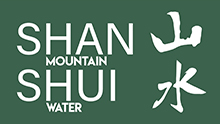
An important aspect of eremitism in historical China is the evolution of eremitical thought into aesthetic expression as poetry, then painting. Chinese hermit thought is embedded in the historical context of reclusion, wherein officials at court consciously left employment to seek anonymity in distant rural and mountainous settings. By the tenth century Song dynasty era, the poetics and philosophizing associated with eremitic life evolved into painting. The highlight school of painting is the “waters and mountains,” school, sometimes referred to in the West as the “rivers and mountains” school.
Shan Shui is a rich web-based resource, a semi-annual journal of essays and articles by Chinese and Western contributors. Shan Shui describes itself as “Mountain and Water Painting Magazine.” Studies of historical Chinese painting are featured, but the editorial goal is wider and more ambitious:to bring Chinese art, culture, and aesthetics into communication with Western counterparts, broadening the perspective of Chinese art to in order to address nature, philosophy, and understanding.
“This magazine aims to give a voice to thecontemporary Chinese and non-Chinese scholars and artists with a background of studying in China.” “Our main objective: To spread the knowledge of contemporary Chinese painting outside of China, and to give voice to the great artists of the last century as well as to the new young artists.” More fully:
“Our purpose is to create a cultural bridge between two great cultures, in order to establish a rich and fruitful dialogue in the sphere of Chinese painting. Chinese mountain and water painting is one of the main artistic expressions in China, characterized by more than 1500 years of evolution and revolutions,and has found a new golden age of creativity and expression in the contemporary times. This magazine will introduce some modern and contemporary Chinese artists, the theories of Chinese painting andthe views of environmental aesthetics, in a way that is reachable for everybody, from the academic world to any curious mind interested in the field of Chinese art and culture.”
Because of the origins in eremetic thought and practice, the expression of these works and artists is of particular interest. At the same time that the new atists reflect on the past their artistic expression unconsciouly or directly reflects on the place of nature, solitude, and self, refreshing historical origins and suggesting how to apply antiquity to modern life.
An important aspect of eremitism in historical China is the evolution of eremitical thought into aesthetic expression as poetry, then painting. Chinese hermit thought is embedded in the historical context of reclusion, wherein officials at court consciously left employment to seek anonymity in distant rural and mountainous settings. By the tenth century Song dynasty era, the poetics and philosophizing associated with eremitic life evolved into painting. The highlight school of painting is the “waters and mountains,” school, sometimes referred to in the West as the “rivers and mountains” school.
Shan Shui is a rich web-based resource, a semi-annual journal of essays and articles by Chinese and Western contributors. Shan Shui describes itself as “Mountain and Water Painting Magazine.” Studies of historical Chinese painting are featured, but the editorial goal is wider and more ambitious:to bring Chinese art, culture, and aesthetics into communication with Western counterparts, broadening the perspective of Chinese art to in order to address nature, philosophy, and understanding.
“This magazine aims to give a voice to thecontemporary Chinese and non-Chinese scholars and artists with a background of studying in China.” “Our main objective: To spread the knowledge of contemporary Chinese painting outside of China, and to give voice to the great artists of the last century as well as to the new young artists.” More fully:
“Our purpose is to create a cultural bridge between two great cultures, in order to establish a rich and fruitful dialogue in the sphere of Chinese painting. Chinese mountain and water painting is one of the main artistic expressions in China, characterized by more than 1500 years of evolution and revolutions,and has found a new golden age of creativity and expression in the contemporary times. This magazine will introduce some modern and contemporary Chinese artists, the theories of Chinese painting andthe views of environmental aesthetics, in a way that is reachable for everybody, from the academic world to any curious mind interested in the field of Chinese art and culture.”
Because of the origins in eremetic thought and practice, the expression of these works and artists is of particular interest. At the same time that the new atists reflect on the past their artistic expression unconsciouly or directly reflects on the place of nature, solitude, and self, refreshing historical origins and suggesting how to apply antiquity to modern life.
Among representative articles:
* Reclusive Culture in Chinese Mountain and Water Painting
* On the Innovation and Transcendence of Contemporary Shan Shui Painting … Lingnan School of Painting
* The Philosophy of Life in the Philosophy of Art in Shitao ’s Huayulu
* Ecological culture in Chinese traditional Mountain and Water Painting
* Unity between Human and Nature in Chinese Mountain and Water Painting
* Oneness: On the Chinese Understanding of Nature
* Innocence in the Mountains: Zhang Cangjian’s Practice of Chinese Mountain and Water Painting
* Non-anthropocentric Phenomenology in Chinese Mountain and Water Painting
* The Creation of Landscape Painting is the Unity of Passion, Universals and Technique
Thanks to Shan Shui editor Giacomo Bruni for bringing the site to our attention.
URL: https://www.shanshuiprojects.net/magazine/
<
